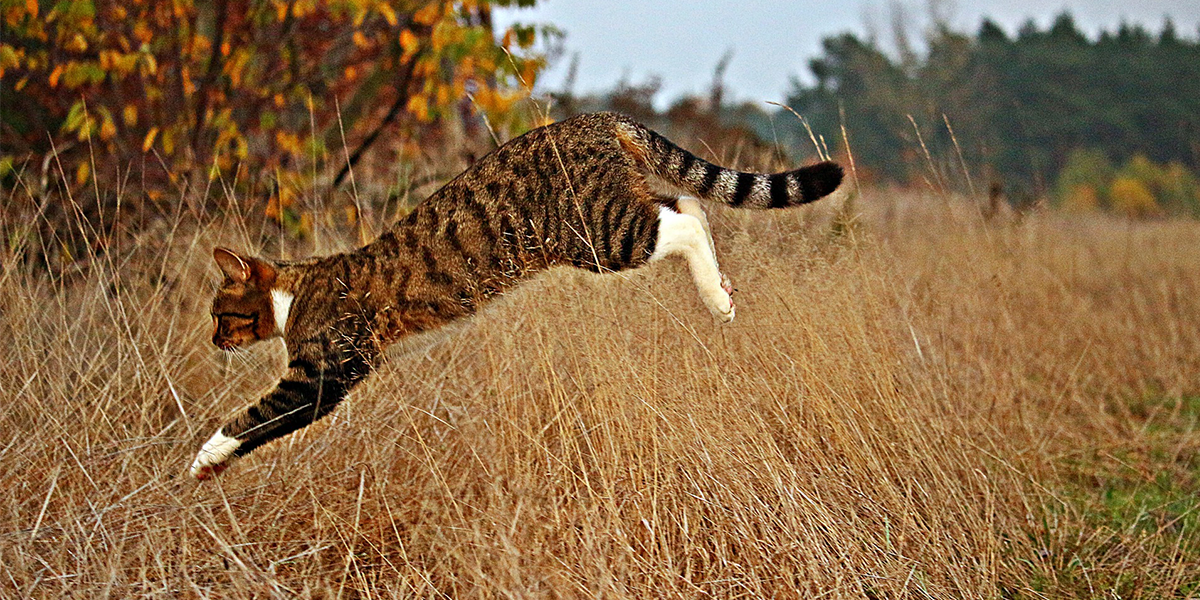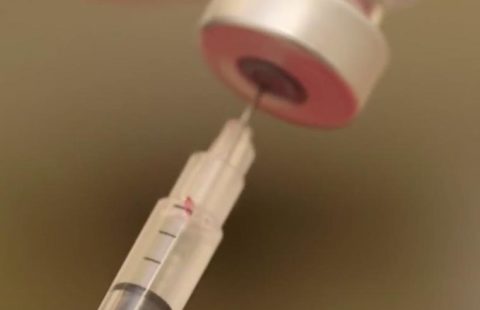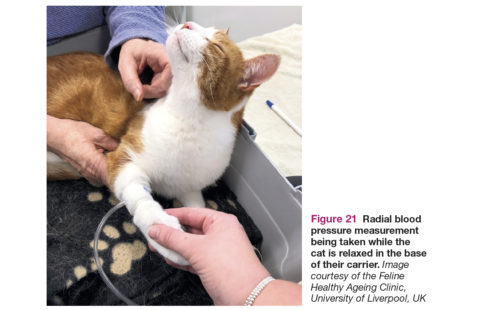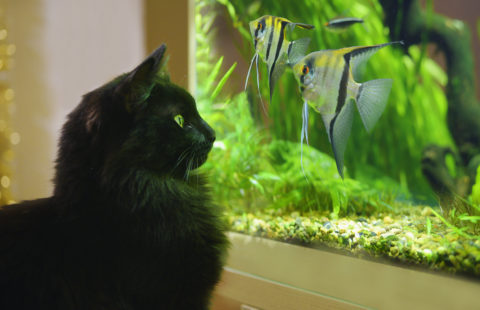One of the most common changes a cat owner would make about their pet cat is their ability to hunt, especially if they find dead (or alive!) prey in their homes on a regular basis. A question that cat owners often ask is ‘why does my cat still hunt when I provide them with cat food’? In this article, we look in greater detail at the hunting behaviour of domestic cats and explain some of the reasons why our pet cats still carry out hunting behaviour despite being fed by their owners.
Why do domestic cats hunt prey?
The domestic cat is a predatory species meaning that cats hunt for their food. Much like their wild ancestors, domestic cats are specialised solitary hunters. Up until fairly recent times, cats were primarily kept as pest controllers rather than companions. At this point only the best hunters were able to survive and reproduce, meaning that our pet cats today are descended from the most adept hunters. As we have done very little selective breeding of cats (in comparison with dogs) and generally exert little control over their breeding, the instinctive need to perform hunting behaviour remains strong.
Cats are referred to as ‘obligate carnivores’. This means that cats need to eat meat to survive and fulfil their specific and unique nutritional requirements. As cats hunt alone their prey is small in size as this is all they are capable of catching on their own. The most common prey type for cats is small mammals and birds. Some cats are also skilled enough to catch larger prey such as rabbits. Due to the small size of their prey, cats need to make several kills throughout a 24-hour period to consume their daily energy requirements. In fact, a cat that has no supplementary food from an owner can make as many as 10 to 20 kills each day.
As a result of this natural feeding pattern, cats are adapted to eat small amounts of food on a frequent basis.
Despite being specifically adapted to hunt for food, domestic cats will usually take advantage of alternative food sources that may be available, such as food found through scavenging or in the case of pet cats, food that is provided for them by their owners.
How do domestic cats hunt?
Cats commonly follow a set sequence of behaviours when hunting prey as described in the diagram below.

Flow diagram depicting the most common sequence of hunting behaviour of the domestic cat.
Cats usually approach their prey by stalking it. This involves the cat being in a crouched position, with their head outstretched. Slow movements are used on the initial approach which may speed up to a sprint the closer the cat gets to the prey. As the cat gets to a close enough distance to be able to capture the prey, the cat stops and prepares to spring forward. At this point, you may witness the cat holding itself in a tense position before a brief sprint and springing forward to strike the prey with one or both of their front paws.
You may notice your cat participates in some but not all of the hunting behaviours in the sequence, depending on the individuals hunting expertise. Owned cats often capture their prey but do not always kill and consume it which can be a cause of frustration, particularly for wildlife lovers. We look at the reasons for this behaviour next.
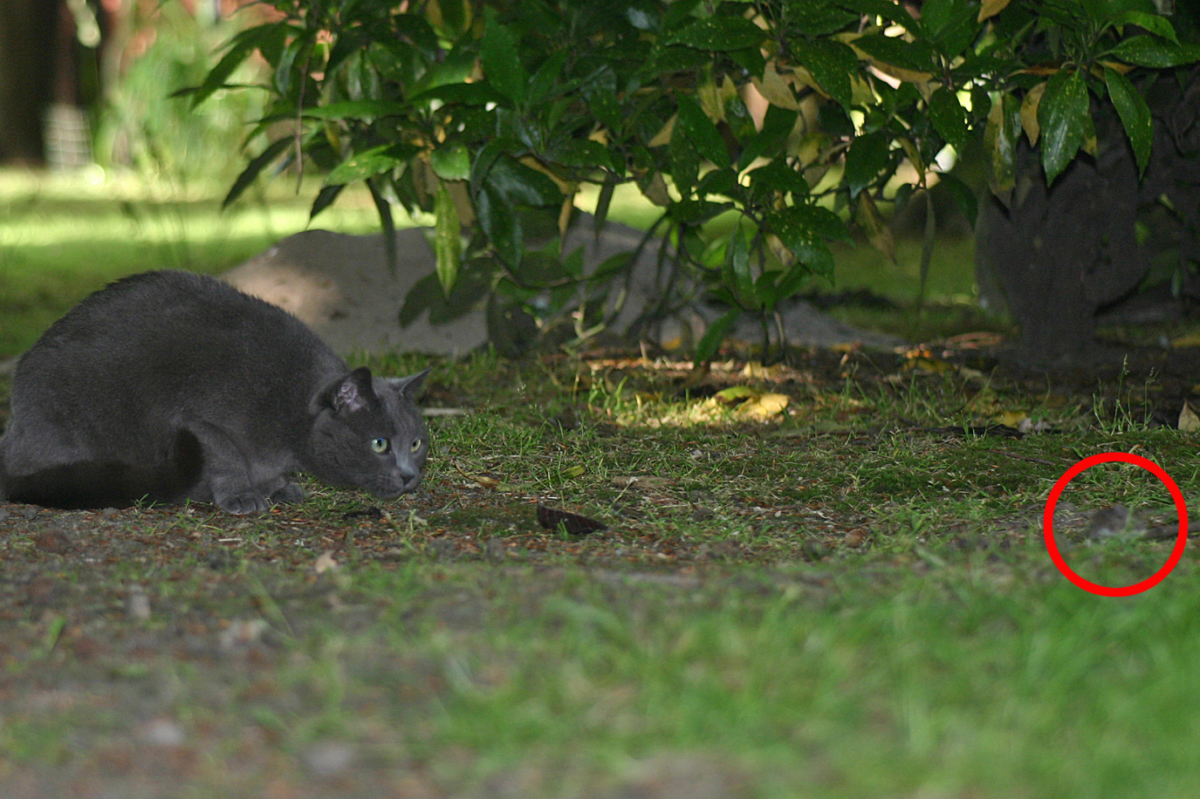
A cat locating prey (circled) within the environment. ©Anne-Marie Dossche
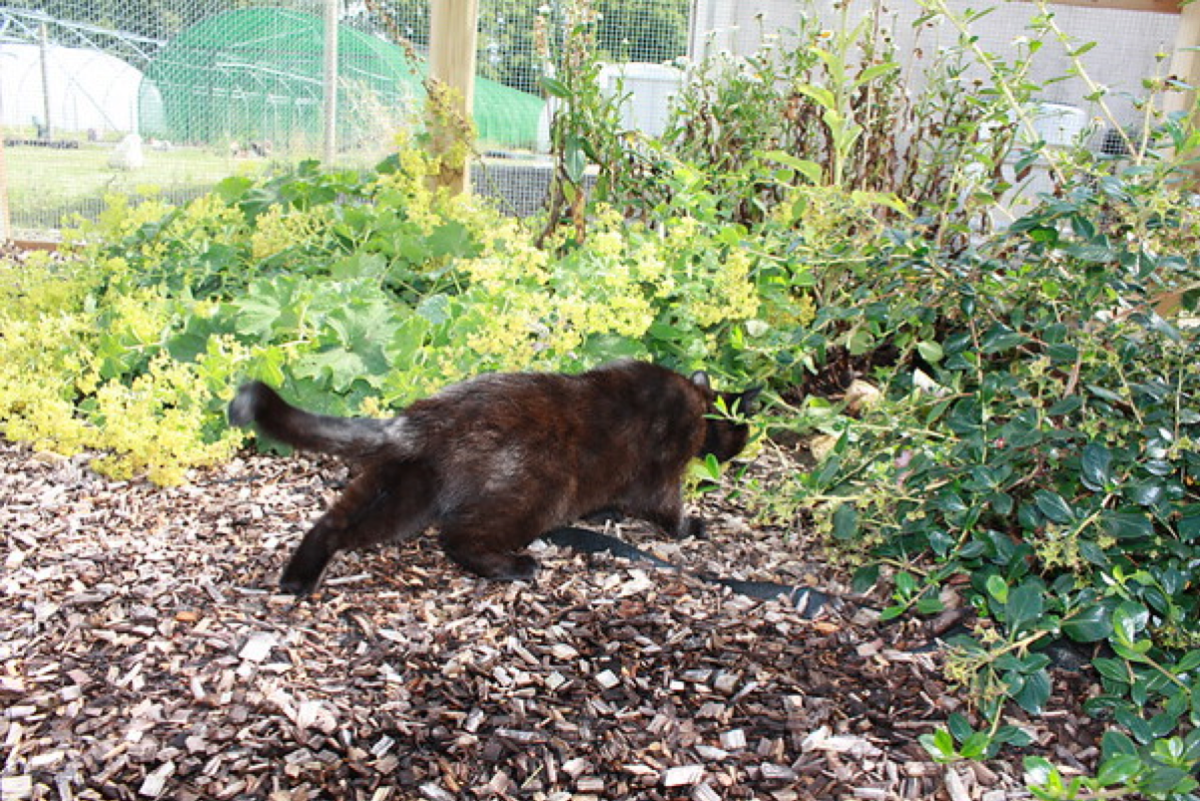
A cat in stalking position. ©Sarah Ellis.
Is hunting always motivated by hunger?
When cats feel hungry, like us, they are motivated to eat food. The motivation to hunt prey, however, is only partly related to hunger. This is because as a species that hunts alone (as opposed to in groups) cats rely solely on themselves to provide enough food. If cats were to wait until they were hungry before hunting they would run a high risk of starving to death due to the difficult nature of hunting and capturing prey. It is estimated that there is less than a fifty percent chance of success at each hunting attempt. Similarly, there may simply not be any prey available when a cat becomes hungry. As a result, cats have learnt to be opportunistic in their feeding, meaning that they will change their activity patterns depending on food availability. Therefore, if the opportunity to hunt presents itself a cat will partake in predatory behaviour, regardless of whether they are hungry or not at the time.
There is one area of a cat’s hunting behaviour that is linked to hunger and that is whether a cat kills the prey they have captured. Cats are far more likely to kill and consume the prey they capture if they are hungry at the point of hunting compared to if they had eaten well prior to hunting. This explains why many cats participate in hunting behaviour but do not necessarily kill or consume the prey they catch, instead bringing it home and leaving it.
Due to their opportunistic natures, if a second predatory opportunity presents itself immediately after a cat has just caught and killed prey they will more than likely engage in further predatory behaviour. We can assume that this is due to the benefits of a second meal outweighing the risk of losing the first.
Studies have found that owned cats are more likely to hunt if they are only fed scraps of food compared to cats fed commercial cat food. The average well-fed pet cat only partakes in around 3 hours of hunting each day. This is compared to an unowned, feral cat with no food supplementation who may hunt for around 12 hours each day. Therefore, feeding our pet cats does appear to cause some reduction in hunting behaviour.
Alternatively, cats may also be driven to hunt to provide more variety into their diet as often owners report that they see their pet cat hunt immediately after eating their cat food. Cats are inherently neophilic which means they like to try new and different foods and enjoy variety. If cats are fed the same food repeatedly they may try to find variety through hunting.
This explains why cats often bring home prey but don’t always kill or consume it. Owners often interpret this as their cat bringing them ‘presents’ but it is more likely that the cat simply prefers their tasty cat food to the prey they caught.
The relationship between ‘play’ and ‘predation’
Owners often witness their cats apparently ‘playing’ or ‘toying’ with their prey after catching it. So why do cats do this?
‘Toying’ with their prey is considered to be a displacement behaviour performed by cats which is brought about by the conflict of needing to kill their prey and the fear of potentially being injured by their prey as a result. Studies have found that the more fearful of injury a cat was, the more ‘play’ before dispatch was reportedly seen.
Alternatively, when adult cats play with toys that we provide them with we essentially see them performing predatory behaviour directed towards inanimate objects. Studies have found that adult cats show more intense and prolonged play with toys that resemble actual prey items. Similarly, the hungrier the cat was at the time of object play the more intense and prolonged the play sessions were. Both of these factors indicate that cats consider these toys to be prey when they are playing.
Is there anything I can do to help reduce my cat’s hunting behaviour?
Feeding your cat will have some effect on their hunting behaviour but because hunting is not entirely motivated by hunger, providing your cat with greater amounts of food will not reduce their desire to hunt and will provide them instead with the opportunity to overeat and gain weight.
As we have discussed hunting is an innate feline behaviour so trying to completely eliminate this behaviour could potentially compromise a cat’s welfare.
The following tips are welfare friendly ways to help reduce your cats hunting behaviour:
- Provide a highly palatable cat food with a high meat content.
- Feed your cat small, frequent meals throughout the day and night to mimic a cats natural feeding pattern. Timed feeders or puzzle feeders can be used to help owners who are out during the day.
- Introduce some variety to the foods offered to your cat where possible.
- Increase the frequency of play with your cat. Short yet frequent play sessions most closely resemble a cat’s natural predatory pattern. Choose toys that closely resemble a cat’s natural prey to increase engagement. This provides your cat with an alternative outlet for predatory behaviour and uses up energy reserved for hunting.
- Consider keeping your cat in at times when prey species are most active, for example, dawn and dusk. Any change to a cat’s routine should be implemented slowly, over an extended period of time and carefully monitored to ensure it is not having any negative impact on the cat.



